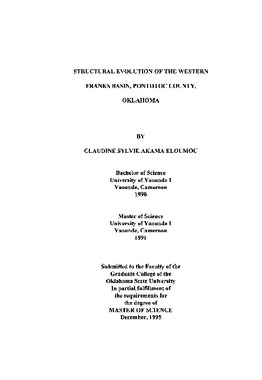| dc.contributor.author | Eloumou, Claudine Sylvie Akama | |
| dc.date.accessioned | 2014-10-01T13:33:38Z | |
| dc.date.available | 2014-10-01T13:33:38Z | |
| dc.date.issued | 1995-12-01 | |
| dc.identifier.uri | https://hdl.handle.net/11244/12727 | |
| dc.description.abstract | The Western Franks Basin is a located within the northeastern part of the Arbuckle Mountains between the Lawrence Uplift to the north and the Hunton Anticline to the south. It is bounded by the Stonewall Fault to the north and the Franks Fault Zone to the south. The two boundary faults diverge to the east and converge to the west giving to the basin a triangular shape. Nine structural cross-sections and three structural contour maps were constructed in order to describe and interprete the structural features and their spatial arrangement in the area. A fence diagram was drawn to display the stratigraphic relationships of the formations present in the Western Franks Basin. The construction of the cross-sections, contour maps, and fence diagram were based on the surface geology, the scout-ticket information, and the author's interpretation of the well logs. A petrographic study of a section of the Franks Conglomerate was carried out to determine the provenance of the carbonate fragments present in the unit. The petrographic study was also used to interprete the diagenetic history of the unit.These structural, sedimentologic, and petrographic data were analyzed and interpreted to reconstruct the structural evolution of the basin. The Franks Fault was probably formed during the rifting stage of the Southern Oklahoma Aulacogen as a normal fault, and then later was rejuvenated as a strike-slip fault during the deformation stage of the Aulacogen. The Franks Fault Zone (FFZ) is characterized by a reverse separation along its three main parallel faults that dip to the south and converge at depth to form a subvertical fault. This geometry of the FFZ was interpreted as a flower structure. The reverse separation along the three branches of the Franks fault zone averages 300 feet. But the fault as a whole shows about 5000 feet reverse separation. The normal separation the Stonewall Fault is estimated to be about 5000 feet. A sudden change in thickness of the Atoka Formation from about 500 feet to the south to about 1,500 feet to the north indicated the presence of a fault named the Atoka Growth Fault which was tectonically active during the Atoka deposition. This fault trends east-west and becomes shallower toward the west where it exhibits a normal separation of about 1,000 feet, almost twice that of the eastern part. The SW-NE trending surface faults ofthe Hunton Anticline continue in the subsurface within the basin, and dip to the southeast. The folds of the basin mostly formed in close association with the faults. | |
| dc.format | application/pdf | |
| dc.language | en_US | |
| dc.publisher | Oklahoma State University | |
| dc.rights | Copyright is held by the author who has granted the Oklahoma State University Library the non-exclusive right to share this material in its institutional repository. Contact Digital Library Services at lib-dls@okstate.edu or 405-744-9161 for the permission policy on the use, reproduction or distribution of this material. | |
| dc.title | Structural Evolution of the Western Franks Basin, Pontotoc County, Oklahoma | |
| dc.type | text | |
| osu.filename | Thesis-1995-E48s-2.pdf | |
| osu.accesstype | Open Access | |
| dc.type.genre | Thesis | |
